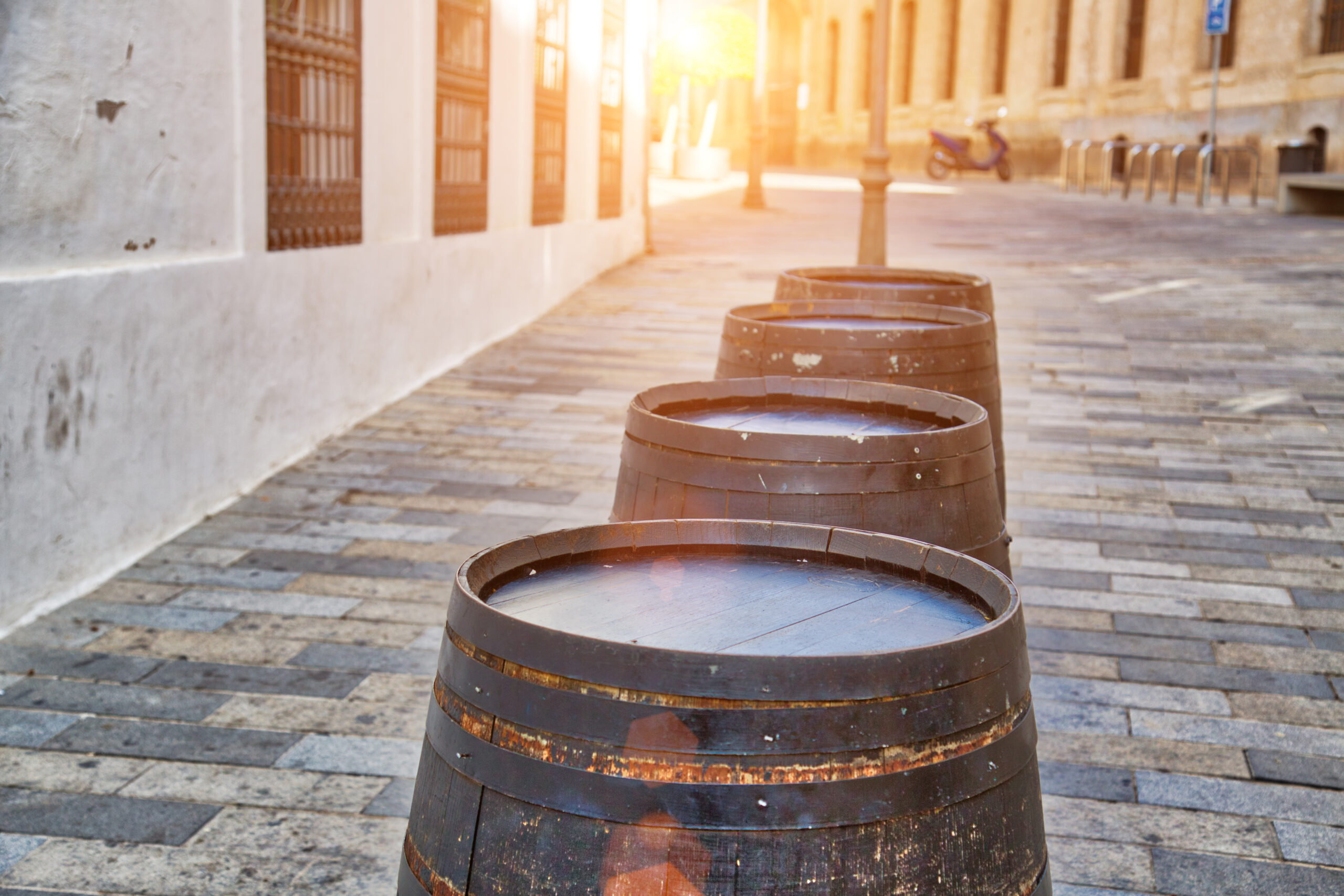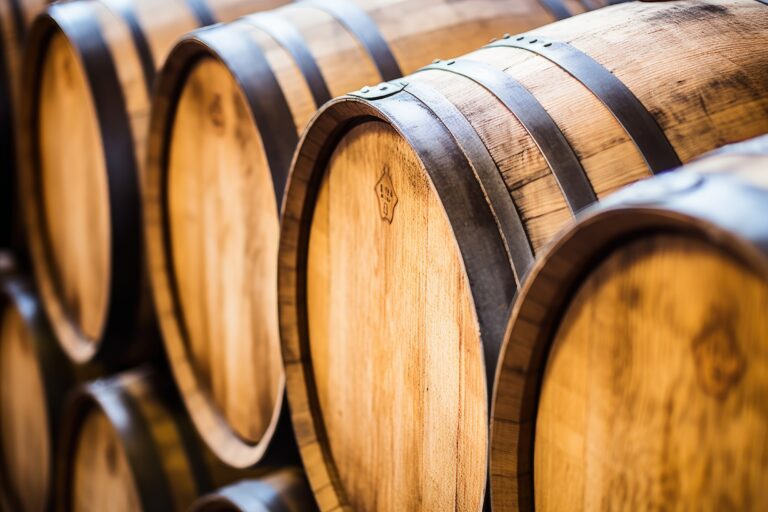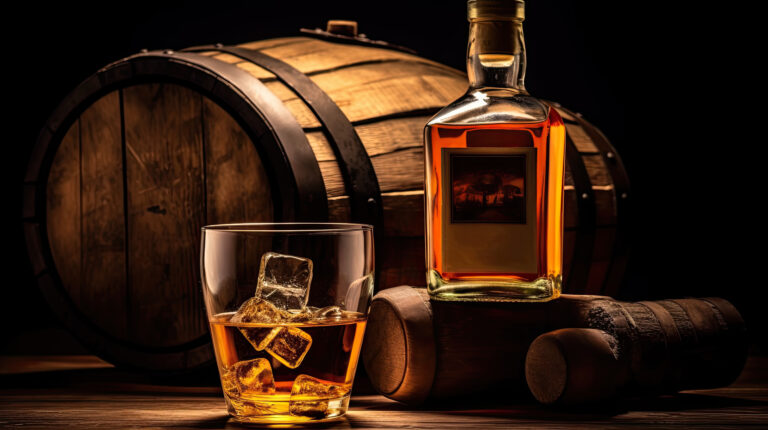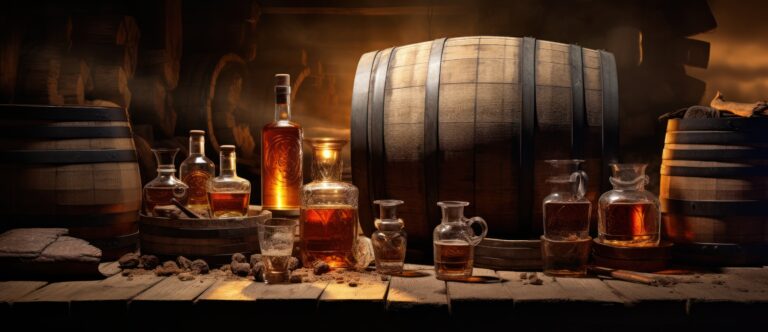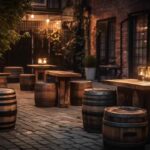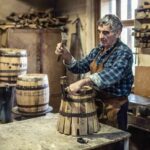So, you’re curious about the cost of a brand new whiskey barrel, eh? Well, get ready to open your wallet a bit if you’re looking to acquire one of these essential oak casks. Any true whiskey enthusiast knows that the barrel aging process is just as vital as the spirit itself when it comes to developing nuanced flavor profiles and captivating aromas. Freshly charred oak barrels, particularly those crafted for aging bourbon whiskey, can easily range from $500 to $1000 apiece, and that depends on the barrel size and the oak wood used. And that’s just for a standard issue! If you’ve got your sights set on an artisanal, handcrafted barrel from a specialty cooperage, you could be looking at double that investment. But hey, think of it this way: you’re investing in the future of your own signature house whiskey, something that’ll have your friends green with envy. The transformations that happen inside a virgin oak barrel over years of patient aging are truly something special. Now, if only those extra Benjamins would magically appear!
Diving Into Whiskey Barrel Costs
New whiskey barrels definitely aren’t pocket change, but the final price tag can fluctuate quite a bit depending on the specific type of barrel and where you decide to purchase it. Standard 53-gallon charred American white oak barrels typically fall in the $200 to $500 range. If you’re after a barrel made from higher-grade white oak, you should anticipate spending anywhere from $350 to $700.
American white oak is widely regarded as the benchmark for aging whiskey. Notably, barrels sourced from oak grown in the Ozark Mountains of Missouri are highly sought after by distillers and can command a premium price. The char level or toast level – essentially how much the inside of the barrel has been burned – also plays a significant role in the final cost. A heavier char translates to more pronounced flavors being imparted to the whiskey during its maturation. Opting to buy barrels in bulk directly from a cooperage (a barrel maker) generally offers a more economical route compared to buying a single barrel from a homebrew supply store. Some cooperages even offer “whiskey aging kits” that include a barrel and all the necessary tools to age and bottle your own creation. Used barrels that have already nurtured whiskey or bourbon can present a more affordable alternative. However, keep in mind that they’ll have less active char remaining, meaning they won’t contribute as much oak flavor during a second aging cycle. Ultimately, investing in a high-quality new charred oak barrel is a commitment, but it’s also a fundamental ingredient in crafting a premium aged spirit. Spending a little more upfront for the right barrel can make all the difference in the final character of your whiskey.
Exploring the Different Types of Whiskey Barrels
The barrels employed for aging whiskey come in a variety of shapes, sizes, and wood types. The three most prevalent types you’ll encounter are:
American white oak barrels stand out as the most popular choice. They contribute delightful notes of vanilla, caramel, and spice. White oak boasts a tight grain structure that allows for a controlled amount of airflow, which is crucial for gradual oxidation during the aging process. Used bourbon barrels are also quite common, largely because bourbon can only be aged in new charred oak barrels. The residual bourbon flavor permeates the wood, lending hints of maple syrup, nuts, and cocoa when these barrels are repurposed for aging whiskey. This practice allows distillers to save on costs while adding an extra layer of complexity to the spirit. European oak barrels, such as those made from French oak, impart flavors of dried fruit, particularly cherry, along with subtle herbaceous undertones. French oak has a wider grain, allowing for more air interaction with the whiskey. This can lead to faster aging but also introduces more tannins, which can result in an undesirable bitterness if the whiskey is left to age for too long. In the end, the type of barrel – whether it’s new or used, how heavily it’s charred, and the geographical origin of the oak – all significantly influence the final taste of your whiskey after its years of patient maturation. The true artistry lies in the aging process, and the barrel serves as the essential canvas.
Unpacking the Factors That Influence Barrel Prices
The cost of a new whiskey barrel can fluctuate considerably based on several key factors:
Wood Type: The specific type of wood used has a substantial impact on the price. Oak barrels, especially those made from American white oak, generally command the highest prices. Oak is ideally suited for aging whiskey due to its porous nature, which facilitates the transfer of flavors to the spirit. While more exotic woods might carry a higher initial cost, they are less traditional and can yield inconsistent results.
Toast Level: The toast level, which refers to the extent to which the wood is charred, also affects the price. A deeper char contributes more intricate flavors to the whiskey, so barrels with a heavier toast tend to be more expensive. The most common char levels are #3 char, #4 char, and what’s known as a heavy char.
Origin: The geographical source of the wood plays a role in pricing. American white oak sourced from the forests of the Ozarks or the Appalachian Mountains is highly prized for bourbon barrels and thus carries the highest cost. European oak, often originating from France or Eastern Europe, is a popular choice for Scotch whisky casks but generally costs less than its American counterpart.
Volume: Unsurprisingly, larger barrels come with a higher price tag than smaller ones, as they require more wood and resources to produce. The standard sizes include the 53-gallon bourbon barrel, the 90-100 liter single malt Scotch cask, and sherry butts, which hold approximately 500 liters. Larger casks, such as puncheons, will be the most expensive. To sum it up, you can anticipate paying anywhere from $200 to $1000 for a new charred oak whiskey barrel, depending on these various factors. It’s wise to shop around at different cooperages to find a barrel that aligns with your specific needs and budget.
Understanding the Average Cost for a New Oak Barrel
A new oak barrel suitable for the craft of aging whiskey can range in price from $200 up to $1000, with the final figure hinging on the size and the source of the oak. Barrels crafted from American white oak tend to occupy the higher end of this spectrum. You’ll typically encounter a premium for barrels made from oak that has undergone extended drying and seasoning processes, as this meticulous preparation allows the wood to impart richer flavors to the whiskey during its maturation.
The standard barrel sizes you’ll encounter are the 53-gallon barrel, a common choice among craft distillers, and the slightly larger 60-gallon version. For a small craft distillery, you can expect to invest at least $500 to $700 for a new handcrafted 53-gallon American white oak barrel. Larger distilleries, however, often benefit from volume discounts when placing bulk orders with barrel makers and coopers.
Some distillers express a preference for repurposing barrels that previously held bourbon or brandy, believing that the residual flavors from the initial use contribute an extra layer of complexity to the final product. Rejuvenated used barrels will generally cost between $150 and $350.
Ultimately, it’s a matter of “you get what you pay for.” Higher-quality, properly seasoned new oak barrels will invariably yield a smoother, more flavorful aged whiskey. If your goal is to craft an exceptional, truly memorable whiskey, investing in superior barrels is a wise decision. Your discerning customers will undoubtedly taste the difference.
Exploring Used Barrels – More Economical Options
Used barrels present a more budget-conscious approach if you’re looking to embark on the journey of aging whiskey. Cooperages frequently have a stock of barrels that have previously been used to age bourbon, wine, or other spirits. These barrels typically undergo a process of reconditioning and re-charring before being offered for resale.
While used barrels won’t impart quite the same intensity of flavor as new charred oak barrels, they can still deliver excellent results at a significantly lower cost. Many craft distilleries initially rely on used barrels as they build the capital to invest in new ones.
The price range for used whiskey barrels typically falls between $50 and $200, with the final cost influenced by factors such as:
- Size and toast level
- Previous use (e.g., bourbon, wine)
- Condition and the extent of re-charring
- Current supply and demand dynamics
Don’t overlook resources like Craigslist, Facebook Marketplace, or your local cooperages as potential sources for finding used whiskey barrels for sale in your vicinity. Some cooperages also list used barrels on their websites.
When you compare this to the $500 to $1,000+ price tag associated with a new charred barrel, used barrels emerge as an accessible option for home distillers or craft distilleries operating on a tighter budget to begin the crucial process of aging and developing their product. While the final flavor profile might exhibit subtle differences, used barrels can still yield a quality aged spirit without breaking the bank.
Examining Extra Features That Can Drive Up Barrel Prices
Additional features and customizations can significantly impact the final price of a new whiskey barrel.
Charring Level: The depth of the char on the interior of the barrel directly influences the flavor of the aged whiskey. Deeper char levels contribute darker, smokier notes. Barrels with a higher char level, such as a Level 3 or 4 char, often carry a 10-30% premium over a standard char.
Toasting: Subjecting the wood to a toasting process before charring introduces subtle hints of caramel or vanilla. Barrels that undergo both toasting and charring typically command a price increase of 15-40%.
Custom Wood: Opting for barrels crafted from oak species beyond the standard American white oak or European oak, such as hickory, maple, or cherry wood, is considered a premium choice and can increase the cost by 20-50%. These unique wood types impart distinct flavor compounds to the whiskey.
Barrel Size: Larger barrels, particularly those exceeding the 53-gallon standard, require more intricate craftsmanship and higher-quality staves, leading to a significant price increase for sizes like 63, 92, or 125 gallons. Conversely, smaller barrel sizes, such as 5 or 10 gallons, are also more expensive on a per-gallon basis due to their novelty and the specialized construction.
New vs. Used: Brand new, “virgin” barrels that have never before held whiskey are more expensive than their used counterparts. Used barrels, having already contributed flavor to one batch of whiskey, are often offered at a discount to craft distilleries seeking a more economical aging solution. Expect to pay 50-200% more for a new barrel compared to a used barrel with similar specifications.
The ultimate price of a premium whiskey barrel is determined by the specific combination of wood type, char level, size, and whether it’s new or used. Additional customizations and the barrel maker’s reputation also factor into the overall cost.
Smart Tips for Securing the Best Barrel Deal
When venturing into the realm of buying a used whiskey barrel, securing a favorable deal involves employing some astute shopping strategies. Here are some valuable tips to help you unearth quality barrels at the most competitive prices:
Explore Multiple Sources: Don’t limit your search to a single vendor. Take the time to compare prices across various websites that specialize in selling used barrels, such as Oak Barrel, Barrel Broker, and Barrel Factory. Private sellers on platforms like Craigslist or Facebook Marketplace frequently list barrels for sale at potentially lower costs.
Consider Bulk Purchases: If your plans involve aging whiskey for commercial resale or if you require multiple barrels for your home endeavors, purchasing several at once can often qualify you for a bulk discount. Don’t hesitate to inquire with the seller about potential price reductions for buying two or more barrels.
Evaluate Barrel Size and Toast: The most common barrel sizes you’ll encounter are 53 gallons and 59 gallons. While larger barrels typically carry a slightly higher price tag, they require less frequent topping off during the aging process. The barrel toast refers to the intensity of the charring on the interior, ranging from light to heavy. While heavier toasts can yield darker, smokier whiskeys, these barrels tend to be more expensive. For the best value proposition, consider opting for a medium toast.
Engage in Negotiation: Don’t shy away from negotiating with private sellers to potentially shave off 10-15% from the asking price. Clearly express your serious interest as a buyer while emphasizing your desire to secure the most favorable deal. Review completed listings to gauge the recent selling prices of similar barrels to establish a fair price range before making an offer. With some skillful bargaining, you can often snag a barrel at a real bargain!
Look for Minor Imperfections: Small dents, dings, or superficial stains on the exterior of a barrel typically won’t compromise the aging process and can often translate to a lower price. As long as the barrel maintains its structural integrity and doesn’t leak, minor cosmetic flaws are easily overlooked, particularly if you intend to store it in a warehouse or basement. Prioritize the internal condition and the toast level when assessing the quality.
Prime Places to Acquire Quality and Affordable Barrels
When it comes to sourcing affordable, high-quality whiskey barrels, you have several viable options to explore:
Local Distilleries: Reach out to craft distilleries in your local area. Many of them periodically sell used barrels that previously held bourbon, rye, or other spirits. Since these barrels have typically seen only a limited period of use, they often remain in excellent condition but are offered at a more budget-friendly price compared to new ones. You might be able to find a suitable barrel for a few hundred dollars.
Online Retailers: Explore websites such as Barrelsonline.com, Oakbarrels.com, and Whiskeybarrels.com, which offer a diverse selection of both new and used whiskey barrels across a range of price points. New charred oak barrels on these platforms typically start in the $200-$500 range, depending on the size. Used barrels will generally be found on the lower end of this spectrum. These online retailers frequently run sales and promotions, so keeping a close eye on their offerings might lead you to a great deal.
Wholesale Suppliers: For larger volume purchases, consider reaching out to major barrel suppliers like Independent Stave Company, Oak Chips, and Canton Cooperage. They specialize in selling whiskey barrels by the truckload at wholesale prices. However, keep in mind that you’ll likely need the appropriate licensing to make purchases from these suppliers.
Opting for bulk purchases often presents the most cost-effective solution if you plan to age and bottle your own whiskey or if you’re looking for barrels for decorative purposes. With a bit of patience and diligent searching, you can certainly find high-quality used or new whiskey barrels that align with any budget. Remember that the barrel you ultimately choose will exert a significant influence on the flavor profile of your aged spirits, so take your time to find the perfect one.
FAQs – Addressing Common Barrel Cost Questions
How much does a brand new whiskey barrel typically cost? Expect to invest between $200 and $500 for a standard 53-gallon charred oak barrel. The precise price will depend on the type of oak (with American white oak being the standard), the toast level (light, medium, or heavy char), and whether it’s domestically sourced or imported.
Where are the most cost-effective barrels sourced? Look for barrels crafted in America, particularly in states like Kentucky or Tennessee. These regions boast a long-standing tradition of cooperage and barrel-making. While barrels from Scotland or Japan are renowned for their quality, they tend to incur significantly higher costs due to import fees.
Can used barrels be more budget-friendly? Absolutely! Used bourbon or wine barrels that have undergone a re-coopering process can offer substantial cost savings. Reusing barrels is also an environmentally conscious choice. A used barrel might range from $100 to $350, as it has already undergone the expensive charring and toasting stages. However, be aware that used barrels will impart more complex flavors from the liquid previously aged within them.
Are smaller barrels more affordable? Mini barrels with capacities ranging from 3 to 5 gallons do tend to be more budget-friendly, typically priced between $50 and $200. However, it’s important to note that smaller barrels facilitate faster aging due to the increased surface area to volume ratio. This can lead to the whiskey taking on oak flavors more rapidly than in a standard-sized barrel. For an optimal balance of cost and aging characteristics, a 10- to 15-gallon barrel presents a good middle ground to consider.
In summary, for the best value, aim for an American-made, 10- to 15-gallon used charred oak barrel. With a bit of diligent searching, you can likely find a high-quality barrel to kickstart your own whiskey aging project for under $500.
Final Thoughts
So there you have it – a comprehensive look at what you can expect to shell out for a brand new whiskey barrel. As you’ve seen, the price can indeed vary quite a bit depending on the specific type of barrel that catches your eye and where you ultimately source it. The good news is that once you’ve acquired your barrel, with proper care and attention, it should serve you well for several years, rewarding you with batch after batch of your very own delicious homemade whiskey. And who knows, if you truly hone your craft, you might even find yourself selling a few bottles down the line and recouping some of your initial investment. But that’s a conversation best saved for another time! For now, go ahead, secure your barrel, fill it with your chosen spirit, and prepare to experience the unique satisfaction of aging your own whiskey. Cheers to that!
